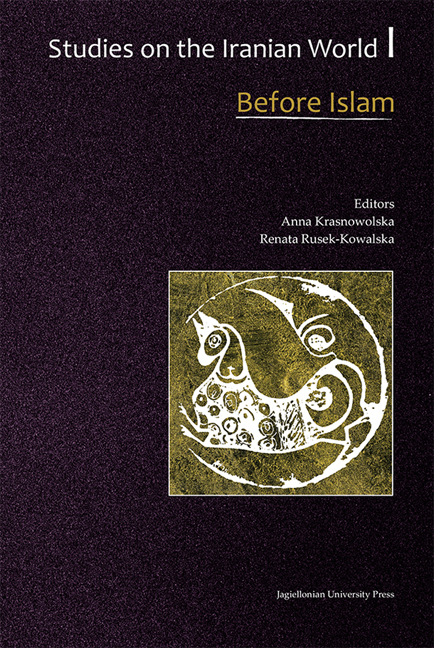Book contents
- Frontmatter
- Contents
- Foreword
- Linguistics
- Literature
- Religion
- History
- Wahrām Čōbīn the Rebel General and the Militarization of the Sasanian Empire
- A Tale of Two Great Kings: Artabanus and Vologaeses
- Realia for Sasanian History: Mint Networks
- New Data on the Development of the Indo-Iranians in the Bronze Age
- Archaeology
Realia for Sasanian History: Mint Networks
from History
Published online by Cambridge University Press: 12 January 2018
- Frontmatter
- Contents
- Foreword
- Linguistics
- Literature
- Religion
- History
- Wahrām Čōbīn the Rebel General and the Militarization of the Sasanian Empire
- A Tale of Two Great Kings: Artabanus and Vologaeses
- Realia for Sasanian History: Mint Networks
- New Data on the Development of the Indo-Iranians in the Bronze Age
- Archaeology
Summary
SUMMARY
Khusro I (531–579 AD) was the first king to have his silver coins marked with the date of issue and the mint name that usually corresponded to the first letters of the place name. From Shapur I (242–271 AD) to Wahram II (276–293 AD), no coins bore a date of issue, but mint names were clearly, although rarely, marked. The interim period – that is, from Narseh (293–302 AD) to Kawad I (488–496 AD, 499–531 AD) – was characterized by two systems of notation for the mint name which became increasingly common, as did the year of issue.
The mint network undoubtedly reflected the royal will, and very often a political reality. Through several case studies, this paper shows how a network of mints can be interpreted in the context of royal propaganda, the politics underlying mint locations, or factual history.
INTRODUCTION
A map of the network of mints that were in operation for each year of the Sasanian period would constitute a source to answer many of the questions that are posed not only by numismatists – for example, on the territorial organization of the Sasanian institution of money – but also by historians.
However, many factors prevent us from creating such maps for the entire period. First, the data that are currently available are too incomplete for us to successfully undertake such a task and there are also other disadvantages related to the coinage itself, the most important of which is the absence of mint names and dates on numerous coins.
The indication on coins of a mint name did not become a standard practice until the second reign of Kawad I, around 500 AD. At that time, the year of issue was also routinely given, and we can therefore establish a list of active mints for each year from 500 to 651 AD. Unfortunately, such a list still cannot produce a map with the location of the mints because many uncertainties about the identity of the mints themselves remain. At that time, most mint names were long, and thus abbreviated, and the identification of these letters that make up a mint's signature with the name of the town or the region where the mint was located often remains hypothetical.
- Type
- Chapter
- Information
- Studies on the Iranian World: Before IslamMedieval and Modern, pp. 211 - 222Publisher: Jagiellonian University PressPrint publication year: 2015



